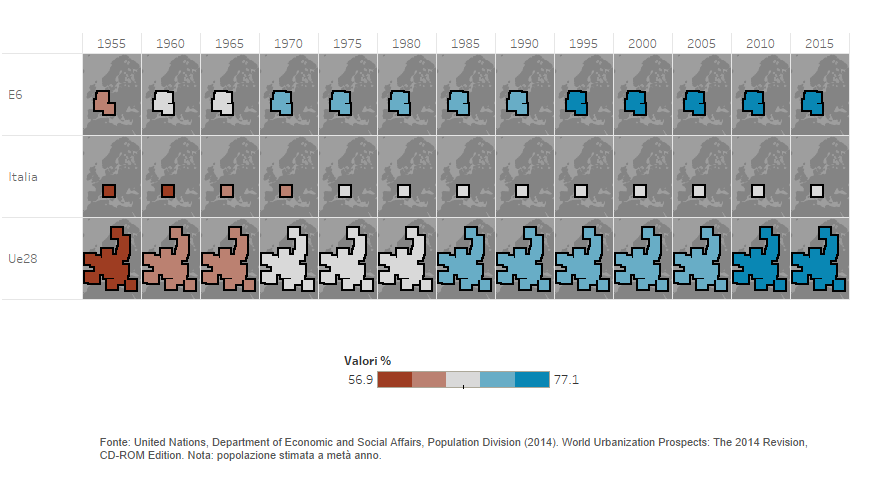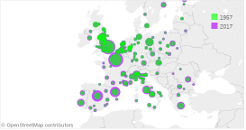Italy is relatively less urbanized than its European partners, but the post-war urbanization process followed a similar path to that of the six founders: a strong growth until the early 1980s, then a slowdown, and finally >read more
a recovery from 2000 to today. In the first phase, urban growth in Italy was faster than the average of partners, with convergence between countries; in the second phase, the pace of growth was noticeably slower, bringing the difference between Italy and the Eu6 at higher levels than those of 1957.
In Europe there are 158 cities with more than 300,000 inhabitants. They have an average size of 964,000 inhabitants, but only half count more than 550,000 inhabitants >read more
and only 35 outnumber one million people, including Rome,Milan, Naples and Turin, ranking 5th, 7th, 12th and 18th place, respectively among the big European cities. Since 1957 the number of Italian cities with more than 300,000 inhabitants has almost doubled (from 17 to 31) and the population has increased by 44 percent. Similar dynamics also affected France, the Netherlands and Poland; the expansion of German cities was less significant (population +10 percent, cities from 17 to 22); more accentuated that of Spanish ones (population +137 percent, cities from 5 to 13).
Since 1960 the share of children born outside of marriage has grown significantly throughout Europe. Our country, however, differed considerably in the levels: in the sixties, the share of children born outside of marriage >read more
was just over 2 percent in Italy, while in the rest of Europe it was around 5 percent. From the mid-seventies, this share began to grow everywhere, but at a slower pace in Italy. Only from 2002, the dynamics of this indicator in Italy has aligned with the European one. Accordingly, in 2012 in Italy about one out of four children were born out of marriage as compared to the 40 percent in the Eu28 and 42 percent in the Eu6.
The phenomenon of child mortality shows strong convergence in all countries. In 1957, at the signing of the Treaties of Rome, the rate was 39.6 per thousand in all six founding countries. In Italy, the rate was 49.6 per thousand, exactly >read more
10 points above the average. Twenty years later, in 1977, the infant mortality rate in Italy was below the Eu average and below the threshold of 20 per thousand; in 1987 it was below 10 per thousand and in 2000 it was below the average of the Eu6; since 2010, the Italian infant mortality rate has fallen below 3 per thousand, one of the best results among the 28 Member States.
Italy has much lower university education rates than the European average. Since the mid-1990s, the percentage of people aged 30-34 with a University degree has been steadily increasing, tripling between 1992 and >read more
2016 (the share ranged from 8.6 to 26.2 percent). A similar increase was also recorded in the rest of Europe, and over the years the distance between Italy and the Community average was stable around 10 percentage points. The ratio of women graduates to the total number of graduates has generally been higher in Italy than the European average. The dynamics, however, has been similar throughout Europe and resulted in women graduates outnumbering men in the 1990s.
Poverty in Italy is steadily higher than in the European partners. The 2008 crisis had a much stronger effect on our country: after 2010, the material deprivation rate increased by about 5 percentage points in Italy and >read more
by only one point in the six founding countries; similarly, the risk of poverty or social exclusion increased by about 3 percentage points in Italy against just one point for the Eu6.
In our country, social protection expenditure (health, welfare and care) in euro per capita is in line with that in the Eu28, while it is about 1,700 euros lower than the average of the six >read more
founding countries. This is, however, the result of a process of progressive convergence of Italy with European partners, if we consider that in 1995, when Italy emerged from the 1992 crisis, the gap - at constant prices - was over 3,500 euro per capita.
In 1970, the circulating car fleet in Italy and the six founding countries was broadly similar, and included around 20 cars per 100 people. It grew at the same pace until the mid-1980s. >read more
Then, Italy registered a more sustained increase, which opened a gap of about 6 percentage points with the average of the Eu6 aggregate. In 1991, Italy exceeded the threshold of one car per two inhabitants and the indicator continued to grow: currently, there are 61.5 cars per 100 inhabitants in Italy, 54.3 in the average of the six founders and 49.7 in the Eu28.



